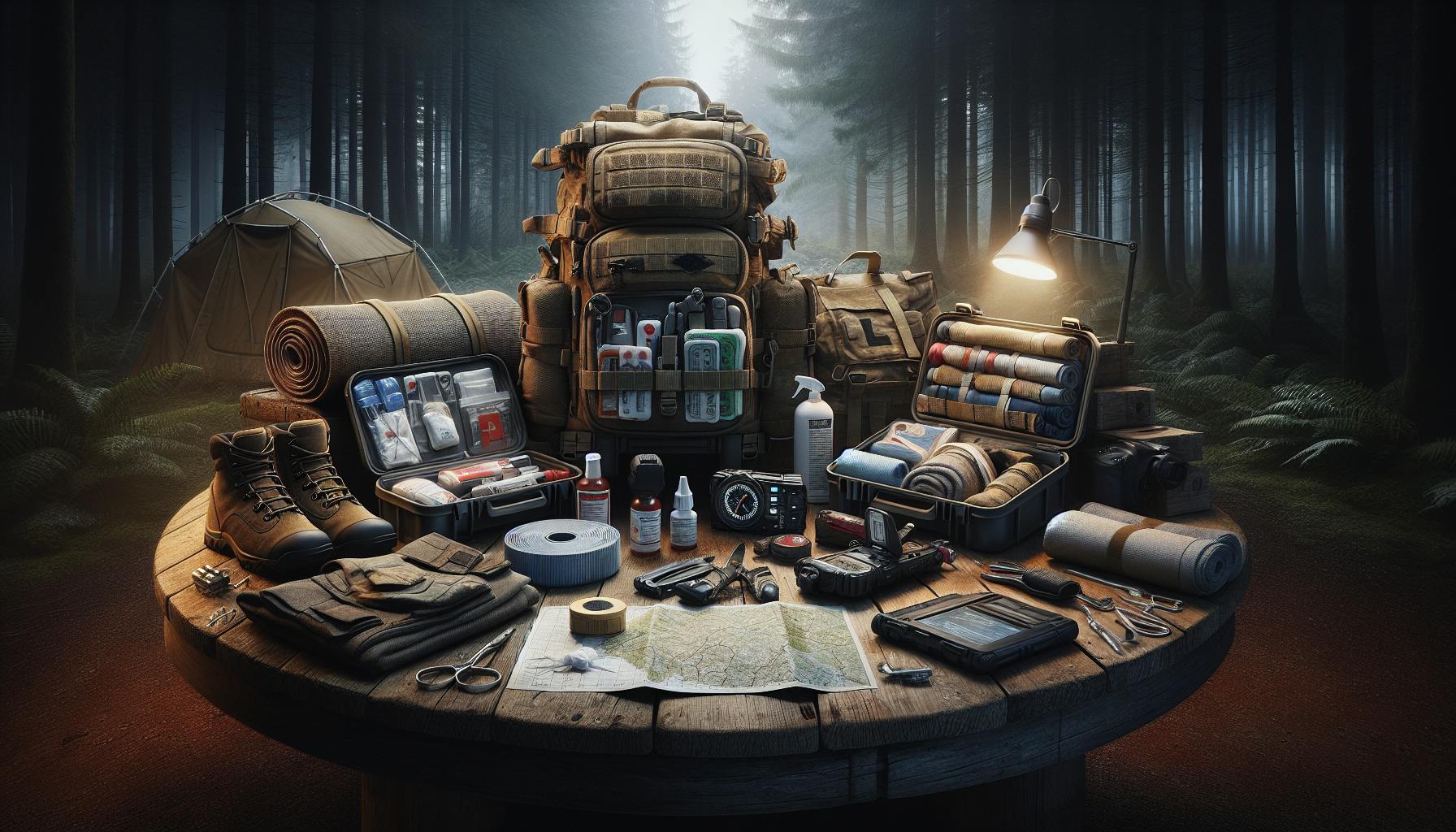Introduction: Preparing for the Unexpected with a Go Bag
When an emergency strikes, every second counts. Having a go bag emergency kit ready allows you to grab essential supplies and get out the door quickly when time is of the essence. A go bag contains the critical items you need to survive for at least 72 hours, giving you a fighting chance no matter the situation.
Whether it's a natural disaster, accident, civil unrest or other crisis, being prepared can make all the difference. A well-stocked go bag provides sustenance, first aid, tools for survival scenarios and other key supplies tailored to your risks and needs. With your go bag ready, you'll have peace of mind knowing you can handle the unexpected.
Assessing Your Emergency Needs and Risks
The first step is taking stock of potential emergencies you may realistically face based on your location, lifestyle and other factors. If you live in tornado alley, supplies for a weather emergency should be top of mind. Those in earthquake zones need to think about ground tremors and infrastructure damage. Consider the likelihood of civil unrest, accidents, fires or floods where you live too.
Make a list of your family’s unique needs as well. Pack extra medications, medical equipment, supplies for pets and infants. If anyone has special dietary requirements, include appropriate food like gluten-free bars. Identify the survival items that make sense for the hazards you’re most likely to encounter.
Choosing the Right Go Bag and Features
A high quality backpack or duffel bag in a muted color from brands like 5.11 Tactical or REI is ideal for a go bag. Look for durable, water-resistant fabrics like 1050D nylon and handy features like MOLLE webbing and straps for organization. Choose a size around 25-50L capacity depending on your needs.
Easy accessibility is key. Bags with pockets and sections allow you to quickly grab what you need in an emergency. Go with zipper enclosures rather than drawstrings for efficiency. Pack items used most often towards the top. Aim for a bag you can securely close but access items without unpacking everything.
Go Bag Essential Items to Include
Food and Water
Having water and food gives you sustenance during an emergency evacuation or if stranded. Pack at least 1 gallon of water per person for a minimum of 3 days using BPA-free bottles. Include non-perishable foods like protein bars, peanut butter packets, nuts, dried fruit and whole grain crackers that provide nutrition and won't spoil. Consider any dietary restrictions too.
First Aid Supplies
A first aid kit tailored to your family’s needs allows you to treat injuries and medical issues. Pack bandages, gauze, antibiotic ointment for wound care. Include OTC meds like ibuprofen, anti-diarrhea meds, electrolyte replacements. Have any essential prescriptions for at least 72 hours. Toss in medical gloves, trauma shears, thermometer and a first aid guide.
Tools and Gear
Pack tools to aid in survival scenarios like a Leatherman multitool, BIC lighters, a Kershaw pocket knife and Mechanix gloves. A Streamlight flashlight and Petzl headlamp with lithium batteries give you light. Toss in a Anker power bank and cords to charge devices. A Midland ER310 radio provides weather band updates. Rope, duct tape and zip ties add versatility for repairs.
Clothing and Bedding
Having weather appropriate clothing from brands like Carhartt and Darn Tough socks keeps you protected in the elements during an evacuation. Pack extra underwear, wool hats and gloves. Emergency blankets from Survive Outdoors Longer and HotHands hand warmers provide warmth. A poncho or rain jacket helps in wet weather. Sunglasses, sunscreen and bandana give sun/dust protection.
Include toilet paper, toothbrush, compact towel and other hygiene items. Keeping clean maintains health and morale in emergencies.
Key Gear for Navigation, Hygiene and Documentation
Navigation Aids
Being able to orient yourself is critical if you're lost or stranded. Pack a compass, maps, Garmin GPS device and whistle. A signal mirror lets you get attention from rescuers. Have a multi-tool with a knife for survival needs.
Hygiene and Sanitation
Maintaining cleanliness is vital for health, especially with limited water. Pack travel soaps, toilet paper, toothbrush, feminine products and other hygiene necessities. Add a folding shovel, trowel and waste bags to properly dispose of feces for sanitation. Hand sanitizer, disinfecting wipes and trash bags help keep tidy.
Copies of Important Documents
Having copies of key documents helps re-establish normalcy after disasters. Scan and save digital copies of ID cards, insurance info, birth certificates secured in a Pelican waterproof case. Tuck away some emergency cash in small bills too.
Pack contact info for relatives, doctors and pharmacies. Write down allergies and medical conditions for reference.
Customizing Your Go Bag for Specific Needs
Tailor your go bag to your family's situation with special additions:
For kids - Pack books, puzzles, playing cards for entertainment. Bring their favorite stuffed animal or blanket for comfort. Include kid-friendly protein bars, Pedialyte, snacks and bottled water.
For pets - Don't forget pet food, medications and copies of their records. Have an extra leash/harness, ID tag, and transport crate. Include waste bags, puppy pads and chew toys to reduce animal stress.
For medical needs - Those with diabetes should pack extra test strips, insulin, ice packs and sharps containers. Have copies of prescriptions and doctor/pharmacy contacts.
For tech - Pack an Anker power bank, charging cables, and offline entertainment on tablets or e-readers. Bring a Zendure solar charger and lithium batteries.
Key Go Bag Packing Tips
Use Clear Organization and Lists
Use clear plastic bags and organizers to neatly separate categories of items in your pack. Make detailed lists of all contents. Review and update it when refreshing your kit.
Check Expiration Dates
When packing food, medicine, and batteries, verify they don't expire within the next year. Mark expiration dates clearly and set calendar reminders to replace them.
Keep It Lightweight
Choose compact, lightweight options whenever possible to prevent overloading. Weigh loaded bags and ensure everyone can reasonably carry theirs if needed.
Waterproof Essentials
Use waterproof cases and bags to secure documents, electronics, and other items that could be damaged if your kit gets wet. This safeguards critical supplies.
Practice Evacuation Drills
Run drills with your family using the go bags to reveal and correct any issues. Time your exit, evaluate carry comfort and accessibility of items. Refine until your system works smoothly.
Recommended Go Bag Storage Tips
- Keep near the exit for fast access during emergency
- Store discretely to avoid theft
- Backup bag in car provides access if away from home
- Cool, dry place prevents damage to contents
- Communicate location so all family can access
Don't Overlook Supplies for Pets
When grabbing your go-bag, don't abandon pets! Pack extra collars/leashes, 3+ days of food, medications and vaccine paperwork for them. A sturdy crate or carrier keeps them secure. Include potty pads, chew toys and treats to reduce animal stress.
Key Items to Keep On Your Person
Rather than only in your pack, wear cargo pants to stash emergency cash, a lighter and mini first aid kit in the pockets. Clip a quality pocket knife to your belt too. Carry your fully charged cell phone, a backup battery and cords at all times. Put a mini flashlight on your keys.
Go Bag Maintenance for Emergency Preparedness
Like any emergency equipment, go bags require periodic maintenance. Mark your calendar to refresh your kit every 6-12 months. Check all expiration dates and replace food, water, medicine and batteries.
Update documents as needed. Reassess risks in your area annually and adjust contents accordingly. Practice evacuation drills to identify and correct any issues. Proper maintenance provides confidence in your emergency preparedness.
Go Bag Emergency Kit Shopping Checklist
Recommended Categories of Supplies
- Durable 25-50L backpack or duffel in muted colors
- 1+ gallon water per person for 3+ days
- Calorie-dense non-perishable snack foods
- Fully stocked first aid kit tailored for your needs
- Flashlights, headlamp, radio, batteries, power bank
- Fire starting tools like lighters and waterproof matches
- Multi-tool, pocket knife, work gloves
- Emergency blankets, hand warmers
- Weather appropriate clothes and footwear
- Hygiene essentials like toilet paper, toothbrush
- Copies of key documents in waterproof storage
Recommended Specific Items
- 5.11 Rush24 tactical backpack or REI Co-op 65 duffel
- Nalgene BPA-free water bottles
- Mountain House freeze dried meals, protein/granola bars
- Adventure Medical Kits first aid supplies
- Streamlight, Petzl headlamps, Anker power bank
- BIC lighters, Zippo fire starter, UCO matches
- Leatherman Sidekick multi-tool, Kershaw pocket knife
- Survive Outdoors Longer emergency blankets
- Darn Tough socks, Carhartt jackets and pants
- Travel soaps, Wet Wipes, Dr. Bronner’s sanitizer gel
- Pelican protective cases for documents
Custom Additions
- Prescriptions, backup glasses/contacts
- Pet crate, food, vaccines
- Portable chargers, tablets loaded with movies/books
- Cash in small bills, prepaid cards
Optional Extras
- Garmin GPS, two-way radios
- Goal Zero solar charger and power bank
- Pepper spray, tactical flashlight
- Water filtration system like LifeStraw
- Tent, sleeping bags for longer evacuation
Key Factors When Choosing Your Emergency Go Bag
Creating an effective emergency go bag requires evaluating your risks, needs and options. Prioritize versatility, durability and practicality over gadgets. Customize for your family’s unique situation. Test and refine your kit until fully prepared.
Realistically Assess Your Risks and Needs
Analyze potential crises in your region like storms, quakes or unrest. Take stock of unique medical requirements. This focuses your prep on actual likely scenarios, not exaggerated doomsday prepping. Customize for real needs.
Select Quality Gear from Trusted Brands
Cheap survival tools often fail when needed most. Spend a bit more for equipment from reputable brands known for durability in extreme conditions based on seasoned outdoorsmen reviews. Quality matters for critical items like first aid, fire, lighting and communication.
Choose Simple, Versatile, Field-Tested Items
The best emergency gear solves problems without unnecessary complexity. Opt for tools with multiple uses like a pry bar/hammer. Verify gear works via field testing. Reliability outweighs flashy features. Pick goods proven effective for years.
Customize for Your Household
While basic supplies stay the same, customize for your situation. Pack entertainment and comfort items to reduce kid stress. Include specialized food and medicine for pets and family members. Add tools you’ll truly need for likely local crises.
Refine Via Hands-On Testing
Paper prepping only goes so far when lives are at risk. Run realistic drills with your kits to expose flaws. Evacuate with your bags to assess carry ability. Replace expired items every 6-12 months. Update and refine until your system works under pressure.
Conclusion
Creating a customized go bag emergency kit with survival essentials ensures you’re ready for the unexpected. Include 3+ days of water, food, first aid, tools and other critical supplies in a durable, organized pack. Store it for quick access during an emergency evacuation and maintain it regularly. Adjust contents based on your family’s unique risks and needs. With practice and proper maintenance, your go bag provides potentially life-saving preparedness for whatever crisis may come. Stay safe out there.


